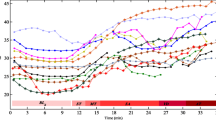Abstract
On the basis of previous experience with biological effects of electromagnetic fields a potential effect of homogeneous sinusoidal magnetic field (50Hz, 10mT) on energy state of rat skeletal muscle was investigated. Two different total body exposures to magnetic field were selected: (1) repeated 1 hour exposure, 2 times a week for 3 months, and (2) acute 1.5 hour exposure (and the appropriate control groups). Important energy metabolites (adenosine triphosphate – ATP, creatine phosphate, creatine, lactate, pyruvate and inorganic phosphate) were analysed by enzymatic and spectroscopic methods in musculus gracilis cranialis.On the basis of the concentration of important energy metabolites the apparent Gibbs free energy of ATP hydrolysis and creatine charge was calculated. Our results demonstrate no influence of this low frequency magnetic field on the level of important energy metabolites in rat skeletal muscle. The conclusion of this study is that neither repeated exposure nor the acute exposure of rats to the sinusoidal magnetic field of given parameters has any important influence on the energy state of the skeletal muscle.
Similar content being viewed by others
References
Hossmann K-A, Hermann DM: Effects of electromagnetic radiation of mobile phones on the central nervous system. Bioelectromagnetics 24: 49–62, 2003
Aran JM, Carrere N, Chalan Y, Dulou PE, Larrieu S, Letenneur L, Veyret B, Dulon D: Effects of exposure of the ear to GSM microwaves: in vivo and in vitro experimental studies. Int J Audiol 43: 545–554, 2004
Foster KR: Do ELF bioeffects studies have relevance to RF bioeffects? In: Forschungsgemanschaft Funk, Berufsgenossenschaft der Feinmechanik und Elektrotechnik and COST 244 Bis (eds), Workshop: Biological and Biophysical Research at Extremely Low- and Radio Frequencies. Berufsgenossenschaft der Feinmechanik und Elektrotechnik, Köln, pp. 27–33, 2003
Salford LG, Brun AE, Eberhardt JL, Malmgren L, Persson BR: Nerve cell damage in mammalian brain after exposure to microwaves from GSM mobile phone. Environ Health Perspectives 111: 881–883, 2003
Brendel H, Niehaus M, Lerchl A: Direct suppressive effects of weak magnetic fields (50 Hz and 16 2/3 Hz) on melatonin synthesis in the pineal gland of Djungarian hamsters (Phodopus sungorus). J Pineal Res 29: 228–233, 2000
Johnston S: Studies on effects of ELF and non-thermal modulated radiofrequency on biological molecules and subcellular fractions. In: Forschungsgemanschaft Funk, Berufsgenossenschaft der Feinmechanik und Elektrotechnik and COST 244 Bis (eds), Workshop: Biological and Biophysical Research at Extremely Low- and Radio Frequencies. Berufsgenossenschaft der Feinmechanik und Elektrotechnik, Köln, pp. 35–42, 2003
Stavroulakis P: Therapeutic effects of electromagnetic fields. In: Stavroulakis P (ed). Biological effects of electromagnetic fields. Springer Verlag, Berlin, Heidelberg, New York, pp. 624–732, 2003
Vojtisek M, Jerabek J, Knotkova J, Hornychova M, Formanek J, Hulinska D, Bittnerova D: The influence of a magnetic field on manganese transport into rat brain. Rev Environ Health 11: 229–233, 1996
Vojtisek M, Knotkova J, Kasparova L, Hornychova M, Frantik E, Hulinska D, Svandova E: Influence of a chemical and/or physical factor/s on the brain. In: Pokorny J (ed). Abstract Book: Coherence and Electromagnetic Fields in Biological Systems. Neoset, Prague, pp. 72–73, 2005
Blank M, Soo L: Enhancement of cytochrome oxidase activity in 60 Hz magnetic field. Bioelectrochem Bioenerg 45: 253–259, 1998
Musil J: The Czech limits and the European prestandards. In: Klauenberg BJ, Miklavcic D (eds). Proceedings of the NATO Advanced Research Workshop on Radio Dosimetry and its Relationship to the Biological Effects of Electromagnetic Fields, Oct. 12–16, 1998, Goyd Martuljek, Slovenia NATO Science Partnership Sub-Series 3: High Technology, Vol. 82, Kluwer Academic Publishers, Dordrecht, The Netherlands, pp. 541–544, 2000
Stefl B, Mejsnar JA, Janovska A: Energy metabolism of rat skeletal muscle modulated by the rate of perfusion flow. Exp Physiol 84: 651–663, 1999
Connett RJ: Analysis of metabolic control: new insight using scaled creatine kinase model. Am J Physiol Regulatory Integrative Comp Physiol 254: R949-R959, 1988
Lawson JWR, Veech RL: Effects of pH and free Mg2+ on the Keq of the creatine kinase reaction and other phosphate hydrolyses and phosphate transfer reactions. J Biol Chem 254: 6528–6537, 1979
Arnold S, Kadenbach B: Intramitochondrial ATP/ADP-ratios control cytochrome c oxidase activity allosterically. FEBS Lett 443: 105–108, 1999
Arnold S, Kadenbach B: Cell respiration is controlled by ATP, an allosteric inhibitor of cytochrome c oxidase. Eur J Biochem 249: 350–354, 1997
Kadenbach B, Arnold S: Minireview. A second mechanism of respiratory control. FEBS Lett 447: 131–134, 1999
Bender E, Kadenbach B: The allosteric ATP-inhibition of cytochrome c oxidase is reversibly switched on by cAMP-dependent phosphorylation. FEBS Lett 466: 130–134, 2000
Lee I, Bender E, Kadenbach B: Control of mitochondrial membrane potential and ROS formation by reversible phosphorylation of cytochrome c oxidase. Mol Cell Biochem 234/235: 63–70, 2002
Detlavs IE et al.: Electromagnetotherapy of traumas and diseases of locomotor apparatus. Riga – RMI 1987; pp. 110–123 (Cited by Jerabek J: The First World Congress of Magnetotherapy, London, 1996)
Pafkova H, Jerabek J, Tejnorova I, Bednar V: Developmental effects of magnetic field (50 Hz) in combination with ionizing radiation and chemical teratogens. Toxicol-Lett 88: 313–316, 1996
Nossol B, Buse G, Silny J: Influence of weak static and 50 Hz magnetic fields on the redox activity of cytochrome-C oxidase. Bioelectromagnetics 14: 361–372, 1993
Dacha M, Accorsi A, Pierotti C, Vetrano F, Mantovani ROG, Conti R, Nicolini P: Studies on the possible biological effects of 50 Hz electric and/or magnetic fields: evaluation of some glycolytic enzymes, glycolytic flux, energy and oxido-reductive potential in human erythrocytes exposed in vitro to power frequency fields. Bioelectromagnetics 14: 383–391, 1993
Shupak NM: Therapeutic uses of pulsed magnetic-field exposure: a reviw. Radio Science Bulletin 307: 9–32, 2003
Author information
Authors and Affiliations
Rights and permissions
About this article
Cite this article
Stefl, B., Vojtisek, M., Synecka, L. et al. Whole body exposure to low frequency magnetic field: No provable effects on the cellular energetics of rat skeletal muscle. Mol Cell Biochem 284, 111–115 (2006). https://doi.org/10.1007/s11010-005-9025-2
Received:
Accepted:
Published:
Issue Date:
DOI: https://doi.org/10.1007/s11010-005-9025-2




